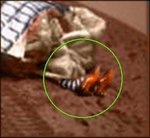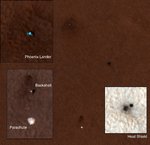Navigation
Install the app
How to install the app on iOS
Follow along with the video below to see how to install our site as a web app on your home screen.
Note: This feature may not be available in some browsers.
More options
You are using an out of date browser. It may not display this or other websites correctly.
You should upgrade or use an alternative browser.
You should upgrade or use an alternative browser.
NASA/JPL Phoenix Mars Lander
- Thread starter syscom3
- Start date
Ad: This forum contains affiliate links to products on Amazon and eBay. More information in Terms and rules
More options
Who Replied?Lucky13
Forum Mascot
Wonder if there'll be any wee green men greeting it at arrival...?
- Thread starter
- #3
syscom3
Pacific Historian
Wonder if there'll be any wee green men greeting it at arrival...?
With NASA's luck, the lander will drop on top of them.
RabidAlien
1st Lieutenant
- Thread starter
- #5
syscom3
Pacific Historian
Matt308
Glock Perfection
This is the one with the retro-parachutes right? And not the inflatable balls surrounding the lander? I can't remember.
johnbr
2nd Lieutenant
Yes it is whit luck this one not turn the retro off at 30ft like the south pole one.
- Thread starter
- #8
syscom3
Pacific Historian
DAMN!!!!
The thing landed OK!
Good job JPL!
The thing landed OK!
Good job JPL!
pbfoot
1st Lieutenant
Amazing work USA
Lucky13
Forum Mascot
Spacecraft reveals look at Mars' polar region
By ALICIA CHANG, AP Science Writer
19 minutes ago
PASADENA, Calif. - NASA's newest outpost in the solar system is a polygon-cracked terrain in Mars' northern polar region believed to hold a reservoir of ice beneath.
Hours after the Phoenix Mars Lander softly landed Sunday in the Martian arctic plains, it dazzled scientists with the first-ever glimpse of the Red Planet's high northern latitudes.
A flood of images sent back by Phoenix revealed a landscape similar to what can be found in Earth's permafrost regions — geometric patterns in the soil likely related to the freezing and thawing of ground ice.
"This is a scientist's dream, right here on this landing site," principal investigator Peter Smith of the University of Arizona, Tucson said in a post-landing news conference.
Phoenix landed on Mars after a 10-month, 422 million-mile journey. After a week checking out its science instruments, the lander will begin a 90-day digging mission to study whether the northern polar region possesses the raw ingredients needed for life to emerge.
Phoenix joins the twin rovers on the Martian surface, which have been exploring the equatorial plains since 2004. Unlike the mobile rovers, Phoenix was designed to stay in one spot and dig trenches in the soil.
Early indications show the lander is healthy, said Barry Goldstein, project manager at NASA's Jet Propulsion Laboratory. The images confirm the lander unfurled its solar panels, hoisted its weather mast and unwrapped the protective covering of its 8-foot-long robotic arm. It'll be several days before the arm will be unstowed.
"Everything just worked like a charm," said Goldstein, who kept up a JPL tradition by passing out bags of lucky peanuts on landing day.
Mission control erupted in cheers when a radio signal from Phoenix was detected after a hair-raising plunge through the atmosphere that required the lander to slow itself down from over 12,000 mph to a 5 mph touchdown using a combination of friction, parachute and thrusters.
Mission managers pumped their fists and hugged one another after the confirmation signal was received.
"They will be remembered forever that they are the first people to explore the polar region of Mars. There's no telling what discoveries would be seen over the next 90 days," said JPL director Charles Elachi.
It's the first successful soft landing on Mars since the twin Viking landers touched down in 1976. Rovers Spirit and Opportunity used a combination of parachutes and cushioned air bags to bounce to the surface four years ago.
Phoenix avoided the fate of another polar explorer, the Mars Polar Lander, which crashed into the Martian south pole after prematurely shutting off its engines in 1999. Phoenix inherited the hardware of a lander that was canceled after the Polar Lander disaster and carried similar instruments flown on the ill-fated 1999 mission.
Phoenix's descent was nearly flawless. The only unexpected turn occurred when it opened its parachute seven seconds later than planned, causing the spacecraft to settle slightly downrange from the bull's-eye target, said Ed Sedivy, program manager at Lockheed Martin Corp., which built the spacecraft.
Phoenix planted its three legs in a broad, shallow valley littered with pebble-size rocks that should not pose any hazard to the spacecraft, project managers said.
"I know it looks a little like a parking lot, but that's a safe place to land. There's not any big rocks," Smith said.
During its prime mission, Phoenix will dig through layers of soil to reach the ice, believed to be buried inches to a foot deep. It will study whether the ice melted during a time in Mars' recent past and will analyze soil samples for traces of organic compounds, which would be a possible indicator of conditions favorable for primitive life. Phoenix is not equipped to detect past or present alien life.
The $420 million Phoenix mission is led by University of Arizona and managed by JPL.
Phoenix Mars Mission - Home
By ALICIA CHANG, AP Science Writer
19 minutes ago
PASADENA, Calif. - NASA's newest outpost in the solar system is a polygon-cracked terrain in Mars' northern polar region believed to hold a reservoir of ice beneath.
Hours after the Phoenix Mars Lander softly landed Sunday in the Martian arctic plains, it dazzled scientists with the first-ever glimpse of the Red Planet's high northern latitudes.
A flood of images sent back by Phoenix revealed a landscape similar to what can be found in Earth's permafrost regions — geometric patterns in the soil likely related to the freezing and thawing of ground ice.
"This is a scientist's dream, right here on this landing site," principal investigator Peter Smith of the University of Arizona, Tucson said in a post-landing news conference.
Phoenix landed on Mars after a 10-month, 422 million-mile journey. After a week checking out its science instruments, the lander will begin a 90-day digging mission to study whether the northern polar region possesses the raw ingredients needed for life to emerge.
Phoenix joins the twin rovers on the Martian surface, which have been exploring the equatorial plains since 2004. Unlike the mobile rovers, Phoenix was designed to stay in one spot and dig trenches in the soil.
Early indications show the lander is healthy, said Barry Goldstein, project manager at NASA's Jet Propulsion Laboratory. The images confirm the lander unfurled its solar panels, hoisted its weather mast and unwrapped the protective covering of its 8-foot-long robotic arm. It'll be several days before the arm will be unstowed.
"Everything just worked like a charm," said Goldstein, who kept up a JPL tradition by passing out bags of lucky peanuts on landing day.
Mission control erupted in cheers when a radio signal from Phoenix was detected after a hair-raising plunge through the atmosphere that required the lander to slow itself down from over 12,000 mph to a 5 mph touchdown using a combination of friction, parachute and thrusters.
Mission managers pumped their fists and hugged one another after the confirmation signal was received.
"They will be remembered forever that they are the first people to explore the polar region of Mars. There's no telling what discoveries would be seen over the next 90 days," said JPL director Charles Elachi.
It's the first successful soft landing on Mars since the twin Viking landers touched down in 1976. Rovers Spirit and Opportunity used a combination of parachutes and cushioned air bags to bounce to the surface four years ago.
Phoenix avoided the fate of another polar explorer, the Mars Polar Lander, which crashed into the Martian south pole after prematurely shutting off its engines in 1999. Phoenix inherited the hardware of a lander that was canceled after the Polar Lander disaster and carried similar instruments flown on the ill-fated 1999 mission.
Phoenix's descent was nearly flawless. The only unexpected turn occurred when it opened its parachute seven seconds later than planned, causing the spacecraft to settle slightly downrange from the bull's-eye target, said Ed Sedivy, program manager at Lockheed Martin Corp., which built the spacecraft.
Phoenix planted its three legs in a broad, shallow valley littered with pebble-size rocks that should not pose any hazard to the spacecraft, project managers said.
"I know it looks a little like a parking lot, but that's a safe place to land. There's not any big rocks," Smith said.
During its prime mission, Phoenix will dig through layers of soil to reach the ice, believed to be buried inches to a foot deep. It will study whether the ice melted during a time in Mars' recent past and will analyze soil samples for traces of organic compounds, which would be a possible indicator of conditions favorable for primitive life. Phoenix is not equipped to detect past or present alien life.
The $420 million Phoenix mission is led by University of Arizona and managed by JPL.
Phoenix Mars Mission - Home
8) Cool stuff!!
Matt308
Glock Perfection
423million miles for that trip. Quite amazing.
A4K
Brigadier General
You said it Matt! Congratulations to them, must have been some work.
- Thread starter
- #14
syscom3
Pacific Historian
Users who are viewing this thread
Total: 1 (members: 0, guests: 1)



